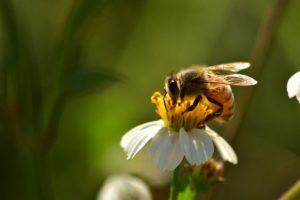
Learn how bees pollinate and how your garden can help them out.
While plants make up a garden, the insects and animals that live among them make the garden. Pollinators enable the propagation of all the various plants and allow us to have food. In a backyard landscape, the health of the plants and trees is partly due to the pollination of bees. Below is a look at how bees pollinate, and what you can do for your landscape in light of it.
Helping Flowers Seed
All plants are competing for attention from the bees and other pollinators, and their petal colors act as signals to come and get food. Bees cannot see red and can only see colors up to a speed of about three miles per hour. Faster than this, and the world goes black and white. However, they can detect ultraviolet light, which some plants emit to still catch their notice. Another way they find flowers is through smell. Bees smell through their antennae, which detect plants like radars. These allow them to smell spatially, so they know exactly where each food source is as if on a map.
Collecting Pollen and Nectar
When bees pollinate, they allow flowers, trees, and more to create seeds. If plants did not make more seeds, our environment could turn bare pretty quickly, no matter how long our trees stand or that our flowers are perennials. As bees go from flower to flower to collect nectar, pollen collects around their hairy legs like pants. They brush off some of the pollen onto other flowers, while the rest goes into the hive to feed their young. The pollen fertilizes the female plant’s egg cells, and thus new seeds begin to form.
Sticking to One Location
Bees are also loyal to specific locations. This faithfulness makes their food scavenging efficient and secures a better chance for one crowd of plants to reseed each year. Through their characteristic “dances,” bees communicate where a rich food source is to their fellows, and so the hive goes out. If anyone is a beekeeper, finding a good spot for the hive becomes easier when a decent flower patch is nearby.
Planting a Bee-Friendly Landscape
For the average homeowner, there are plenty of ways to make the landscape more bee-friendly. Plant flowers with single heads instead of multiple, smaller ones that may produce less pollen or nectar. Plant species that will bloom at different points throughout the year so that the bees always have more food to gather. Using natural lawn fertilizers can help reduce the risk of bee death. To help the bees pollinate through your garden design, contact Edwards Lawn & Home today!
Choose Edwards Lawn & Home
For the past thirteen years, Edwards Lawn and Home has been offering premier residential and commercial services to improve your property all year long. The options are endless from a new patio to a backyard fire pit, let the winners of Angie’s List Super Service Aware serve you! If you’re interested in finding out more about our services or getting a quote, you can contact us online or give us a call at 443-341-6539. For more information about our services or DIY tips and tricks follow us on Facebook, Twitter, LinkedIn, YouTube and Houzz.